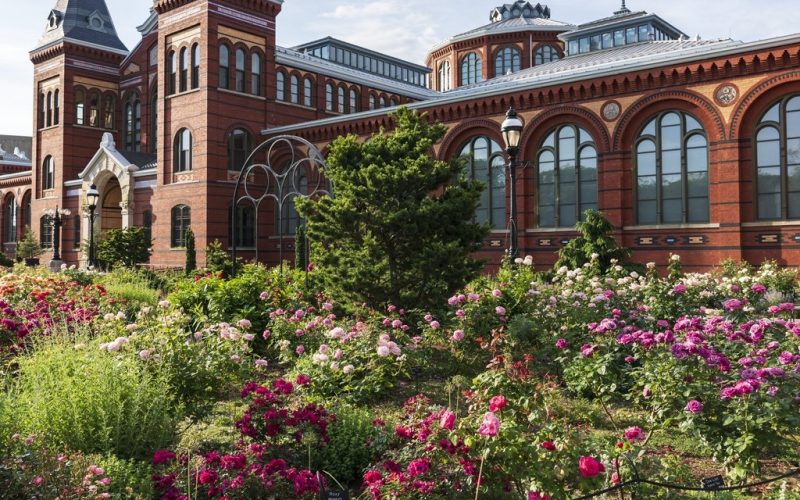
스미소니언 가든
연락처:
제프리 슈나이더
부국장
schneje@si.edu
202-439-5630
우편함 37012 MRC 506
워싱턴, 컬럼비아 특별구 20013-7012
서비스 지역: 워싱턴 D.C.
웹사이트: gardens.si.edu
포커스 영역: 조경 및 원예
조경 및 원예
이 기관의 추가 목표
건물 및 에너지
참여
음식 서비스
투자
연구
교통편
폐기물
물
추가 정보
기후 변화에 대응하기 위해 어떤 특별한 상황과 이니셔티브를 수행했거나 수행할 계획이 있나요?
- 중앙에서 제어되는 스마트 관개 시스템을 통해 태양, 바람, 습도, 온도, 수분 상태를 모니터링하고 필요에 따라 급수 주기를 조정하여 물 사용량을 줄일 수 있습니다.
- 온실 시설에서 빗물을 포집하고 재사용하여 식수 사용을 줄입니다.
- 가능한 경우 지역 수자원 시스템으로의 유출을 줄일 수 있는 다공성 보행 표면으로 전환했습니다.
- 정원을 보다 포용적인 야생동물 서식지로 전환하고 꽃가루 매개체를 지원합니다.
- 모든 정원에 서식지를 전시하고 캠퍼스 전체에 걸친 전시와 해석을 선보입니다.
- 토종 식물을 포함하도록 정원을 전환합니다.
- 잔디밭을 제거하면 해당 구역이 화단으로 전환되어 살충제 및 비료 사용 가능성이 줄어듭니다.
- 잔디 깎는 횟수를 줄이고 잔디 깎는 높이를 높입니다.
- 해충 상황을 관리할 때 생물학적 방제 및 환경 친화적인 통합 해충 관리/식물 건강 전략을 사용하고 불필요한 살충제 살포를 줄입니다.
- 해당되는 경우 재료 재활용에 참여합니다.
- 관련 기관 간 단위에서 생산한 퇴비 사용.
- 자체적으로 지정된 지속가능성 팀을 통해 부서 내에서 채택할 수 있는 잠재적인 지속가능성 관행을 검토합니다.
- 향후 프로젝트를 위해 토양의 질과 건강을 개선할 수 있는 방법을 모색하기 위해 전문가를 영입하는 토양 마스터 플랜에 투자합니다.
- 지속 가능한 제품 또는 관행에 대한 시험: 어스카인드 로즈 시험, 피트모스 이탄 이끼 대체품 시험, 유기농 제초제 시험.
기후 변화를 해결하기 위해 활용할 수 있는 커뮤니티의 가장 시급한 문제나 기회는 무엇인가요?
- 식물의 중요성과 사람들의 삶에서 식물이 갖는 다양한 관계에 대한 대중의 이해를 넓힙니다.
- 멸종 위기에 처한 식물을 효과적으로 옹호하고 보존하는 데 의미 있는 역할을 합니다.
- 도시 환경의 나무 캐노피 늘리기.
- 해수면 상승, 기상이변, 박물관과 정원에 영향을 미치는 갑작스러운 홍수 발생.
- 원예 재배 지역의 변화. 지구 온난화와 장기적으로 따뜻해진 기온에 맞춰 식물 팔레트를 조정합니다.
기후 변화에 대응하기 위해 정원의 어떤 독특한 특징을 활용할 수 있나요?
- 2,500만 명의 청중이 방문합니다. 도시 녹화, 서식지, 수자원 관리, 수분 매개자 등에 대해 교육할 수 있는 기회
- 스미소니언 기관 전반의 강력한 파트너십을 통해 정원을 중심으로 다양한 학제 간 연결이 가능합니다.
기후 변화에 효과적으로 대처하는 데 방해가 되는 기관이나 커뮤니티의 고유한 제약 요인에는 어떤 것이 있나요? 어떻게 하면 이러한 힘의 충돌을 타협에서 벗어나 화해와 화합으로 이끌 수 있을까요?
- 많은 이니셔티브를 처리하기 위해 물류 및 리소스를 확장해야 합니다.





